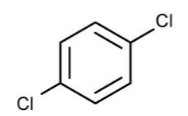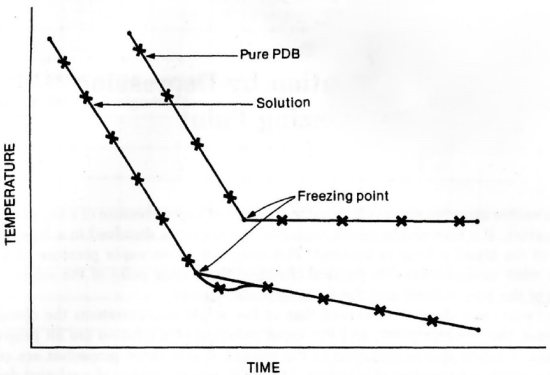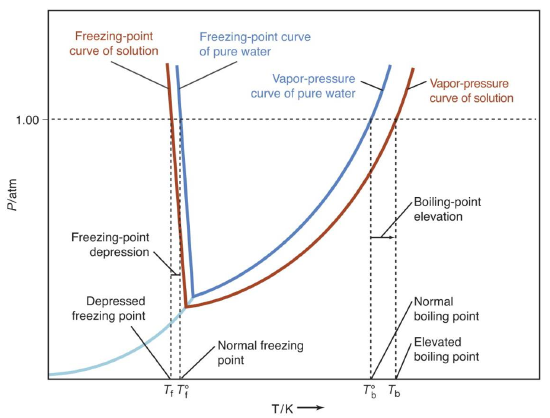4: Determination of the Molar Mass by Freezing Point Depression (Experiment)
- Page ID
- 127039
Objectives
- To determine the molar mass of an unknown solid using the colligative property of freezing point depression.
When a small amount of non-volatile solute is dissolved in a volatile solvent, the vapor pressure of the solvent over the solution will be less than the vapor pressure of the pure solvent at the same temperature. Therefore, the temperature at which the equilibrium vapor pressure reaches atmospheric pressure is higher for the solution than for the pure solvent. As a result, the boiling point of the solution, \(T_{b}\), is higher than the boiling point of the pure solvent, \(T^{o}_{b}\). The amount by which the boiling point of the solution exceeds the boiling point of the pure liquid, \(\Delta T_{b} = T_{b} - T^{o}_{b}\), is called the boiling point elevation. Similarly, because of the reduction in vapor pressure over the solution, the freezing point of the solution, \(T_{f}\), is lower than the freezing point of the pure solvent, \(T^{o}_{f}\). The amount by which the freezing point of the solution is decreased from that of the pure liquid, \(\Delta T_{f} = T^{o}_{f} - T_{f}\), is called the freezing point depression. Figure \(\PageIndex{1}\) below illustrates this behavior for water.
Figure \(\PageIndex{1}\)
The magnitude of the freezing depression produced by a solute is proportional to its colligative molality, \(m_{c}\):
\[\Delta T_{f} =T^{o}_{f} - T_{f} =K_{f} \times m_{c} \label{1}\]
\(K_{f}\) is known as the freezing point depression constant and depends on the solvent used.
In this experiment, you will determine the molar mass of an unknown solid by dissolving a pre-weighed sample in a solvent and measuring the resulting freezing point depression of the solvent. From the measured \(\Delta T_{f}\) and the known \(K_{f}\) value of the solvent, you can then determine the value of \(m_{c}\) using the above Equation \ref{1}. The colligative molality, \(m_{c}\), is related to the molality of the solution, \(m\), by the expression:
\[m_{c} =i \times m \label{2}\]
where \(i\) is the number of solute particles produced per formula unit of dissolved solute, and \(m\) is the number of moles of solute per kilogram of solvent. Since only non-dissociating solutes will be used in this experiment, the value of \(i\) for your unknown solute can be considered to be 1. Thus, you may assume that \(m_{c} = m\). From the experimentally determined value of \(m\) and the mass of solute added, you can determine the molar mass of the unknown solute.
The solvent that will be used in this experiment is para-dichlorobenzene, shown in Figure \(\PageIndex{2}\) below. Para-dichlorobenzene has a \(K_{f}\) value of 7.10 °C·kg·mol-1. It also has a convenient freezing point that is near 60 °C.

Figure \(\PageIndex{2}\)
In order to determine the freezing point of this pure solvent, you must first heat it in a test tube to over 60 °C using a hot water bath, and then measure the temperature as a function of time as the liquid cools. At first, the temperature will fall quite rapidly. When the freezing point is reached, solid will begin to form, and the temperature will tend to hold steady until the sample is all solid. This behavior is shown in Figure \(\PageIndex{3}\) below. The freezing point of the pure liquid is the constant temperature observed while the liquid is freezing to a solid.
The cooling behavior of a solution is somewhat different from that of a pure liquid, also shown in Figure \(\PageIndex{3}\). As discussed earlier, the temperature at which a solution freezes is lower than that for the pure solvent. In addition, there is a slow, gradual fall in temperature as freezing proceeds. The best value for the freezing point of the solution is obtained by drawing two straight lines connecting the points on the temperature-time graph. The first line connects points where the solution is all liquid. The second line connects points where solid and liquid coexist. The point where the two lines intersect is the freezing point of the solution.
Note that when the solid first appears, the temperature may fall below the freezing point, but then it comes back up as more of the solid forms. This effect is called supercooling and is a phenomenon that may occur with both the pure liquid and the solution (Figure \(\PageIndex{3}\)). When drawing the straight line in the solid-liquid region of the graph, ignore points where supercooling is observed. To establish the proper straight line in the solid-liquid region, it is necessary to record the temperature until the trend with time is smooth and clearly established.

Figure \(\PageIndex{3}\)
Procedure
Chemicals: Para-dichlorobenzene (PDB), unknown sample, acetone
Equipment: 600-mL beaker, 100-mL beaker, large test tube, utility clamps, hot plate, lab jack, LabQuest with temperature sensor, thermometer, 1/2 inch magnetic stir bar
Safety
-
The PPE for this lab includes safety goggles, lab coats, and nitrile gloves.
-
Para-dichlorobenzene is used in mothballs and urinal cakes, and so it may have a familiar smell. However, direct inhalation of its vapors may be harmful or even toxic. Students should avoid skin contact with para-dichlorobenzene and direct inhalation of its vapors. All heating of para-dichlorobenzene must be done under a fume hood.
Waste Disposal
All chemicals used must be disposed of in the proper waste container. The acetone and para-dichlorobenzene must not go down the sink!
Part 1: Determining the Freezing Point of Pure PDB
- Take note of the setup, which will be shown by the TA.
- Fill a 600-mL beaker with tap water to the 500-mL line. Place the beaker of water onto the hot plate. This will serve as a hot water bath for the experiment. Use a thermometer to monitor the temperature of the water bath. Begin warming the water while setting up the rest of the experiment, but do not allow the temperature to rise too much above 65°C.
- Weigh a clean, dry large test tube in a 100-mL beaker using an electronic balance and record its mass. Use a weighing boat and weigh out about 30 grams of para-dichlorobenzene (PDB). Slowly add it to the test tube (USE A FUNNEL TO AVOID SPILLS). Reweigh and record the mass of the test tube and the PDB. Calculate the mass of PDB in the test tube by difference. If there are spills of PDB around the balances, clean them up immediately! Use a brush and a weighing boat to collect the crystals, then dispose of them in the waste carboy.
- Add a 1/2 inch magnetic stir bar, then use your utility clamp to attach the large test tube containing the PDB to the stand. Do not force the temperature sensor in the test tube. Ask the TA to double-check your lab setup.
- Setting up the LabQuest: Power up the Vernier LabQuest. Make sure the temperature sensor is plugged in and working. Click on "mode" on the upper right hand of the screen. This will bring you to the data collection setup. Make the following changes: Mode should be time-based; Rate 1 sample/s; Interval 1s/sample; Duration 420s. Click "ok."
- Heat the water bath gently, allowing the temperature to rise slowly to around 65°C. As the temperature of the water bath reaches the melting point of the PDB, it will begin to melt. After most of the solid PDB appears to have melted, insert the temperature sensor into the PDB and support it by clamping. Adjust the bottom of the sensor so that it is about 1-2 cm above the bottom of the large test tube. Start the stirring on the hotplate; it should slowly melt any remaining solid PDB.
- When the temperature of the PDB reaches about 65 °C, stop heating. Power off the hot plate and carefully lower the lab jack and then remove the water bath. Slowly raise the lab jack a few inches so the stirring function will still work (at least 3-4 inches of space between the test tube and the hot plate.)
- Monitor the temperature of the PDB as it cools. Stir the liquid slowly (using magnetic stirring on the hotplate) but continuously to help minimize supercooling. When the temperature of the PDB reaches 62 °C, begin recording its temperature by pressing on the collect button (a single triangle that is pointing to the right) on the LabQuest. Continue until the liquid has solidified to the point that you are no longer able to stir it. Stop the LabQuest by pushing the stop or collect button. Near the melting point, you will observe crystals of PDB in the liquid, and these will increase in amount as the cooling proceeds. Note the temperature at which these crystals first start to appear. Press the file cabinet icon beside Run 1 to store your data and clear the graph.
Part 2: Determining the Freezing Point of PDB with about 2 g Unknown Solute
- Your TA will give out instructions on computing for the weight of the unknown. Once you have made the calculations, carefully transfer about 2 grams of the unknown into the large test tube, taking great care that none of the unknown samples is spilled during this process. If you do spill some, you will need to start this step over with a fresh sample of weighed PDB.
- Raise the hot water bath around the large test tube and heat the PDB-unknown mixture until it is completely melted. Stir well to mix the unknown with the PDB thoroughly. When the temperature of the mixture reaches 65°C, stop heating. Remove the hot water bath as before, and dry off the outside of the test tube with a paper towel.
- Monitor the temperature of the PDB-unknown mixture as it cools. Stir the liquid slowly but continuously to help minimize supercooling. When the temperature of the mixture reaches 60°C, begin recording its temperature by pressing the collect button. Continue until the mixture has solidified to the point that you are no longer able to stir it and stop the LabQuest by pushing the stop or collect button. Note the temperature at which crystals first start to appear. Press the file cabinet icon beside Run 2 to store your data and clear the graph.
- The dependence of temperature on time for the mixture should be similar to that observed for the pure PDB, except that the first crystals should appear at a lower temperature for the mixture. There may be some supercooling, as evidenced by a rise in temperature shortly after the first appearance of crystals.
Part 3: Determining the Freezing Point of PDB with about 4 g Unknown Solute
- Prepare another 2 grams of the unknown sample and carefully transfer it into the large test tube, taking great care that none of the unknown samples is spilled during this process. If you do spill some, you will need to start this step over with a fresh sample of weighed PDB and about 4 grams of unknown.
- Raise the hot water bath around the large test tube and heat the PDB-unknown mixture until both the PDB and unknown solid are completely melted. Stir well to mix the additional unknown with the PDB thoroughly. When the temperature of the mixture reaches 60°C, stop heating. Remove the hot water bath as before, and dry off the outside of the test tube using a paper towel.
- Monitor the temperature of the PDB-unknown mixture as before. When the temperature of the mixture reaches about 57°C, begin recording its temperature by pressing the collect button. Continue until the mixture has solidified to the point that you are no longer able to stir it. Stop recording with LabQuest and press the file cabinet icon to store your data. Note the temperature at which crystals first start to appear. Once again, some supercooling might occur. You may plug in the LabQuest to the computer to analyze your data and save it to your Google drive.
Clean Up
- When you have completed the experiment, melt the PDB-unknown mixture as before and then pour the warm liquid quickly into the waste container. Rinse any remaining residue from the side of your test tube, thermometer, and stirrer directly into the waste container using the small squirt bottle of acetone provided. Try to use as little acetone as possible, but be certain that all of the PDB has been removed before replacing the glassware in your locker. Do not allow any of the acetone or PDB-unknown mixture or rinse to go down the sink.
- Wipe your area clean and return the glassware that you used to the appropriate bins.



